
Title: CAREER: Model-based simulation of wind turbine inflow turbulence and design loads
Sponsor: National Science Foundation
Description:
This research involves the development of untried techniques for efficient simulation of three-dimensional inflow turbulence fields that directly influence wind turbine blade and tower loads. Efficient decomposition of the most energetic turbulence spatial patterns evident in field data (but not ordinarily considered in turbulence simulation for turbine design) are being exploited here. The research aims to show that simulation approaches that address energetic spatial distribution over the rotor, when complemented with structural reliability techniques, can be used in a probabilistic design framework for wind turbines and can, thus, assist in even greater harnessing of wind as an important renewable energy source.
Images:
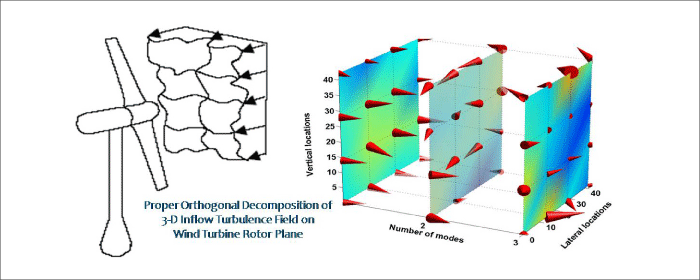
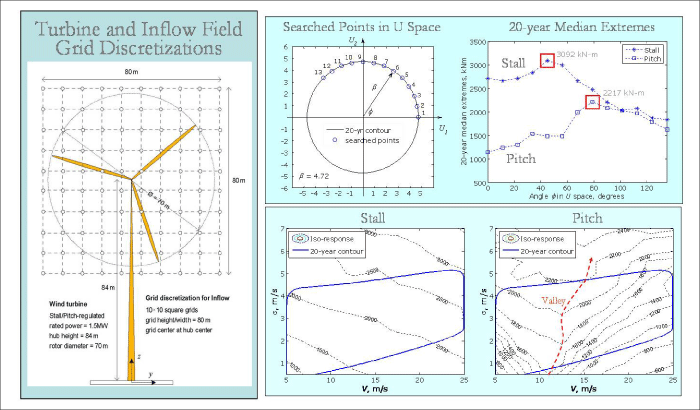
Publications:
K. Saranyasoontorn, L. Manuel, and P. S. Veers, "A Comparison of Standard Coherence Models for Inflow Turbulence with Estimates from Field Measurements," Journal of Solar Energy Engineering, Transactions of the ASME, Vol. 126, No. 4, pp. 1069-1082, November 2004.
K. Saranyasoontorn and L. Manuel, "A Comparison of Wind Turbine Design Loads in Different Environments using Inverse Reliability Techniques," Journal of Solar Energy Engineering, Transactions of the ASME Vol. 126, No. 4, pp. 1060-1068, November 2004.
K. Saranyasoontorn and L. Manuel, "Efficient Models for Wind Turbine Extreme Loads using Inverse Reliability," Journal of Wind Engineering and Industrial Aerodynamics, Vol. 92, No. 10, pp. 789-804, August 2004.
K. Saranyasoontorn and L. Manuel, "On Assessing the Accuracy of Offshore Wind Turbine Reliability-Based Design Loads from the Environmental Contour Method," International Journal of Offshore and Polar Engineering, Vol. 15, No. 2, pp. 132-140, June 2005.
K. Saranyasoontorn and L. Manuel, "Low-Dimensional Representations of Inflow Turbulence and Wind Turbine Response using Proper Orthogonal Decomposition," Journal of Solar Energy Engineering, Transactions of the ASME, Vol. 127, No. 4, pp. 553-562, November 2005.
K. Saranyasoontorn, "A Simulation-based Procedure for Reliability Analysis of Wind Turbines," Ph.D. Dissertation, Department of Civil Engineering, The University of Texas at Austin, May 2006.
K. Saranyasoontorn and L. Manuel, "Design Loads for Wind Turbines using the Environmental Contour Method," Journal of Solar Energy Engineering including Wind Energy and Building Energy Conservation, Transactions of the ASME, Vol. 128, No. 4, pp. 554-561, November 2006.
K. Saranyasoontorn and L. Manuel, "Symmetry Considerations when using Proper Orthogonal Decomposition for Predicting Wind Turbine Yaw Loads," Journal of Solar Energy Engineering including Wind Energy and Building Energy Conservation, Transactions of the ASME, Vol. 128, No. 4, pp. 574-579, November 2006.
K. Saranyasoontorn and L. Manuel, "On the Propagation of Uncertainty in Inflow Turbulence to Wind Turbine Loads," Journal of Wind Engineering and Industrial Aerodynamics, Vol. 96, No. 5, pp. 503-523, May 2008.
Sponsor: National Science Foundation
Description:
This research involves the development of untried techniques for efficient simulation of three-dimensional inflow turbulence fields that directly influence wind turbine blade and tower loads. Efficient decomposition of the most energetic turbulence spatial patterns evident in field data (but not ordinarily considered in turbulence simulation for turbine design) are being exploited here. The research aims to show that simulation approaches that address energetic spatial distribution over the rotor, when complemented with structural reliability techniques, can be used in a probabilistic design framework for wind turbines and can, thus, assist in even greater harnessing of wind as an important renewable energy source.
Images:


Publications:
K. Saranyasoontorn, L. Manuel, and P. S. Veers, "A Comparison of Standard Coherence Models for Inflow Turbulence with Estimates from Field Measurements," Journal of Solar Energy Engineering, Transactions of the ASME, Vol. 126, No. 4, pp. 1069-1082, November 2004.
K. Saranyasoontorn and L. Manuel, "A Comparison of Wind Turbine Design Loads in Different Environments using Inverse Reliability Techniques," Journal of Solar Energy Engineering, Transactions of the ASME Vol. 126, No. 4, pp. 1060-1068, November 2004.
K. Saranyasoontorn and L. Manuel, "Efficient Models for Wind Turbine Extreme Loads using Inverse Reliability," Journal of Wind Engineering and Industrial Aerodynamics, Vol. 92, No. 10, pp. 789-804, August 2004.
K. Saranyasoontorn and L. Manuel, "On Assessing the Accuracy of Offshore Wind Turbine Reliability-Based Design Loads from the Environmental Contour Method," International Journal of Offshore and Polar Engineering, Vol. 15, No. 2, pp. 132-140, June 2005.
K. Saranyasoontorn and L. Manuel, "Low-Dimensional Representations of Inflow Turbulence and Wind Turbine Response using Proper Orthogonal Decomposition," Journal of Solar Energy Engineering, Transactions of the ASME, Vol. 127, No. 4, pp. 553-562, November 2005.
K. Saranyasoontorn, "A Simulation-based Procedure for Reliability Analysis of Wind Turbines," Ph.D. Dissertation, Department of Civil Engineering, The University of Texas at Austin, May 2006.
K. Saranyasoontorn and L. Manuel, "Design Loads for Wind Turbines using the Environmental Contour Method," Journal of Solar Energy Engineering including Wind Energy and Building Energy Conservation, Transactions of the ASME, Vol. 128, No. 4, pp. 554-561, November 2006.
K. Saranyasoontorn and L. Manuel, "Symmetry Considerations when using Proper Orthogonal Decomposition for Predicting Wind Turbine Yaw Loads," Journal of Solar Energy Engineering including Wind Energy and Building Energy Conservation, Transactions of the ASME, Vol. 128, No. 4, pp. 574-579, November 2006.
K. Saranyasoontorn and L. Manuel, "On the Propagation of Uncertainty in Inflow Turbulence to Wind Turbine Loads," Journal of Wind Engineering and Industrial Aerodynamics, Vol. 96, No. 5, pp. 503-523, May 2008.
Title: An offshore wind energy design challenge: the influence of wind and wave load combinations on the extreme response of wind turbines
Sponsor: National Science Foundation and Sandia National Laboratories
Description:
This research is concerned with characterization of the complex offshore environment and the influence of the correlated wind-wave loading on the response of the rotor, support structure, and foundation of offshore wind turbines. Using stochastic simulation of turbulence random fields for the wind and correlated waves and of the aeroelastic response of a wind turbine, load statistics are estimated for used in reliability assessment against prescribed ultimate limit states. Alternative foundation models for fixed offshore wind turbines are also being evaluated. Nonlinear wave theories are being implemented in simulation studies in order to more realistically describe conditions at shallow-water sites. Finally, a spar-buoy support structure for a floating wind turbine is also being studied as part of this project.
Images:
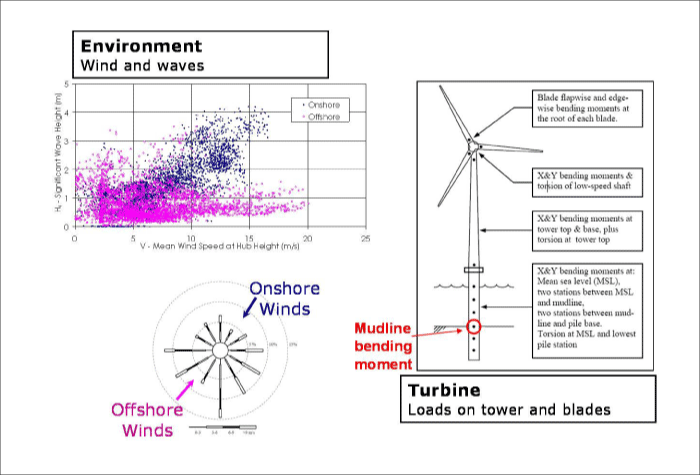
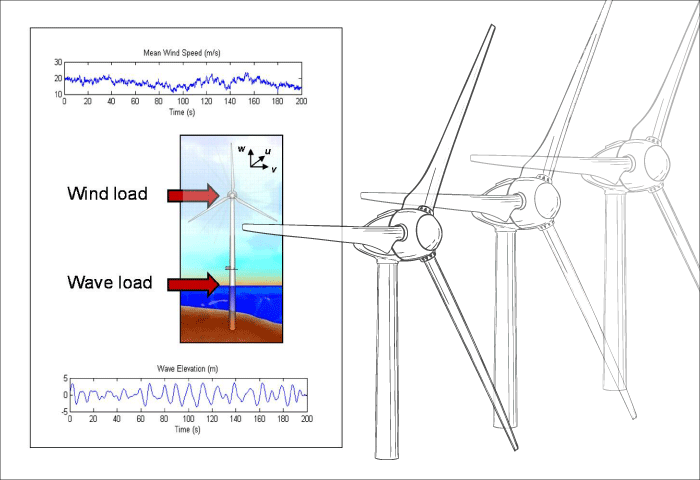
Publications:
P. Agarwal and L. Manuel, "Empirical Wind Turbine Load Distributions using Field Data," Journal of Offshore Mechanics and Arctic Engineering, Transactions of the ASME, Vol. 130, No. 1, 011006, 6 pp., February 2008.
P. Agarwal and L. Manuel, "The Influence of the Joint Wind-Wave Environment on Offshore Wind Turbine Support Structure Loads," Journal of Solar Energy Engineering including Wind Energy and Building Energy Conservation, Transactions of the ASME, Vol. 130, No. 1, 031010, 11 pp., August 2008.
P. Agarwal, "Structural Reliability of Offshore Wind Turbines," Ph.D. Dissertation, Department of Civil, Architectural, and Environmental Engineering, The University of Texas at Austin, August 2008.
P. Agarwal and L. Manuel, "Extreme Loads for an Offshore Wind Turbine using Statistical Extrapolation from Limited Field Data," Wind Energy, Vol. 11, No. 6, pp. 673-684, November/December 2008.
E. A. Bush, "A Comparison of Alternative Foundation Models for Offshore Wind Turbines and Resulting Long-Term Loads," M.S. Thesis, Department of Civil, Architectural, and Environmental Engineering, The University of Texas at Austin, August 2009.
P. Agarwal and L. Manuel, "Simulation of Offshore Wind Turbine Response for Ultimate Limit States," Engineering Structures, Vol.31, No. 10, pp. 2236-2246, October 2009.
P. Agarwal and L. Manuel, "On the Modeling of Nonlinear Waves for Prediction of Long-Term Offshore Wind Turbine Loads," Journal of Offshore Mechanics and Arctic Engineering, Transactions of the ASME, Vol. 131, No. 4, 041601, 11 pp., November 2009.
P. Agarwal and L. Manuel, "Incorporating Irregular Nonlinear Waves in Coupled Simulation and Reliability Studies of Offshore Wind Turbines," Applied Ocean Research, Vol. 33, pp. 215-227, March 2011.
Sponsor: National Science Foundation and Sandia National Laboratories
Description:
This research is concerned with characterization of the complex offshore environment and the influence of the correlated wind-wave loading on the response of the rotor, support structure, and foundation of offshore wind turbines. Using stochastic simulation of turbulence random fields for the wind and correlated waves and of the aeroelastic response of a wind turbine, load statistics are estimated for used in reliability assessment against prescribed ultimate limit states. Alternative foundation models for fixed offshore wind turbines are also being evaluated. Nonlinear wave theories are being implemented in simulation studies in order to more realistically describe conditions at shallow-water sites. Finally, a spar-buoy support structure for a floating wind turbine is also being studied as part of this project.
Images:


Publications:
P. Agarwal and L. Manuel, "Empirical Wind Turbine Load Distributions using Field Data," Journal of Offshore Mechanics and Arctic Engineering, Transactions of the ASME, Vol. 130, No. 1, 011006, 6 pp., February 2008.
P. Agarwal and L. Manuel, "The Influence of the Joint Wind-Wave Environment on Offshore Wind Turbine Support Structure Loads," Journal of Solar Energy Engineering including Wind Energy and Building Energy Conservation, Transactions of the ASME, Vol. 130, No. 1, 031010, 11 pp., August 2008.
P. Agarwal, "Structural Reliability of Offshore Wind Turbines," Ph.D. Dissertation, Department of Civil, Architectural, and Environmental Engineering, The University of Texas at Austin, August 2008.
P. Agarwal and L. Manuel, "Extreme Loads for an Offshore Wind Turbine using Statistical Extrapolation from Limited Field Data," Wind Energy, Vol. 11, No. 6, pp. 673-684, November/December 2008.
E. A. Bush, "A Comparison of Alternative Foundation Models for Offshore Wind Turbines and Resulting Long-Term Loads," M.S. Thesis, Department of Civil, Architectural, and Environmental Engineering, The University of Texas at Austin, August 2009.
P. Agarwal and L. Manuel, "Simulation of Offshore Wind Turbine Response for Ultimate Limit States," Engineering Structures, Vol.31, No. 10, pp. 2236-2246, October 2009.
P. Agarwal and L. Manuel, "On the Modeling of Nonlinear Waves for Prediction of Long-Term Offshore Wind Turbine Loads," Journal of Offshore Mechanics and Arctic Engineering, Transactions of the ASME, Vol. 131, No. 4, 041601, 11 pp., November 2009.
P. Agarwal and L. Manuel, "Incorporating Irregular Nonlinear Waves in Coupled Simulation and Reliability Studies of Offshore Wind Turbines," Applied Ocean Research, Vol. 33, pp. 215-227, March 2011.
Title: The use of full-scale measurements of current velocities and motions at a drilling riser in VIV and fatigue studies
Sponsor: BP America Production Company
Description:
Fatigue damage of risers resulting from vortex-induced vibration is of significant concern, especially at deepwater oil field sites in the Gulf of Mexico. This project is making use of contemporaneous current velocity and riser acceleration measurements from a full-scale instrumented riser. The goal of this research study is to attempt to characterize spatial patterns in current velocity fields and to correlate vortex-induced vibration response to specific current profiles. Spectral and statistical methods are being employed in the analyses. Ultimately, we are interested in assessing the reliability of such deepwater risers in fatigue limit states by combining information on current profile likelihood with the conditional distribution of riser motions and fatigue damage given the current profile.
Images:
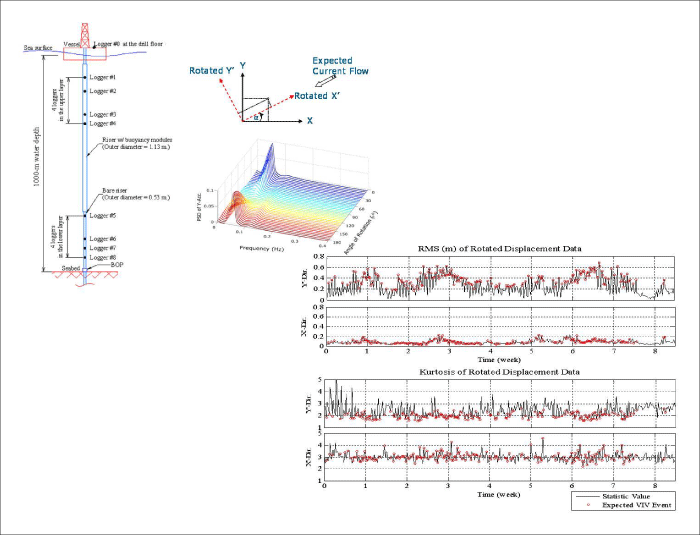
Publications:
T. Srivilairit, L. Manuel, and K. Saranyasoontorn, "On the Use of Empirical Orthogonal Decomposition of Field Data to Study Deepwater Current Profiles for Risers," Proceedings of the Sixteenth International Offshore and Polar Engineering Conference (ISOPE-2006), San Francisco, California, May 2006.
T. Srivilairit, "A Study of Current Velocity Profiles and Vortex-Induced Vibration for Deepwater Drilling Risers," M.S. Thesis, Department of Civil, Architectural, and Environmental Engineering, The University of Texas at Austin, December 2006.
T. Srivilairit and L. Manuel, "Vortex-induced Vibration and Coincident Current Velocity Profiles for a Deepwater Drilling Riser," Journal of Offshore Mechanics and Arctic Engineering, Transactions of the ASME, Vol. 131, No. 2, 021101, 11 pp., May 2009.
C. Shi, "Fatigue Damage Prediction in Deepwater Marine Risers due to Vortex-Induced Vibration," Ph.D. Dissertation, Department of Civil, Architectural, and Environmental Engineering, The University of Texas at Austin, August 2011.
C. Shi, L. Manuel, M. Tognarelli, and T. Botros, "On the Vortex-Induced Vibration Response of a Model Riser and Location of Sensors for Fatigue Damage Prediction," Journal of Offshore Mechanics and Arctic Engineering, Transactions of the ASME, Vol. 134, No. 3, 031802, 10 pp., August 2012.
Sponsor: BP America Production Company
Description:
Fatigue damage of risers resulting from vortex-induced vibration is of significant concern, especially at deepwater oil field sites in the Gulf of Mexico. This project is making use of contemporaneous current velocity and riser acceleration measurements from a full-scale instrumented riser. The goal of this research study is to attempt to characterize spatial patterns in current velocity fields and to correlate vortex-induced vibration response to specific current profiles. Spectral and statistical methods are being employed in the analyses. Ultimately, we are interested in assessing the reliability of such deepwater risers in fatigue limit states by combining information on current profile likelihood with the conditional distribution of riser motions and fatigue damage given the current profile.
Images:

Publications:
T. Srivilairit, L. Manuel, and K. Saranyasoontorn, "On the Use of Empirical Orthogonal Decomposition of Field Data to Study Deepwater Current Profiles for Risers," Proceedings of the Sixteenth International Offshore and Polar Engineering Conference (ISOPE-2006), San Francisco, California, May 2006.
T. Srivilairit, "A Study of Current Velocity Profiles and Vortex-Induced Vibration for Deepwater Drilling Risers," M.S. Thesis, Department of Civil, Architectural, and Environmental Engineering, The University of Texas at Austin, December 2006.
T. Srivilairit and L. Manuel, "Vortex-induced Vibration and Coincident Current Velocity Profiles for a Deepwater Drilling Riser," Journal of Offshore Mechanics and Arctic Engineering, Transactions of the ASME, Vol. 131, No. 2, 021101, 11 pp., May 2009.
C. Shi, "Fatigue Damage Prediction in Deepwater Marine Risers due to Vortex-Induced Vibration," Ph.D. Dissertation, Department of Civil, Architectural, and Environmental Engineering, The University of Texas at Austin, August 2011.
C. Shi, L. Manuel, M. Tognarelli, and T. Botros, "On the Vortex-Induced Vibration Response of a Model Riser and Location of Sensors for Fatigue Damage Prediction," Journal of Offshore Mechanics and Arctic Engineering, Transactions of the ASME, Vol. 134, No. 3, 031802, 10 pp., August 2012.
Title: Atmospheric stability considerations in the design of wind turbines
(collaborator: Sukanta Basu, Texas Tech University)
Sponsor: Texas Higher Education Coordinating Board (ARP) and Sandia National Laboratories
Description:
In the design of wind turbines today, inflow turbulence is only simulated for near-neutral atmospheric stability considerations. Especially at Great Plains sites, stable boundary layer flows can alter the mean longitudinal wind speed profile and also introduce speed shear and wind direction variation that can be very different from neutral flows. For today’s utility-scale wind turbines, stable boundary layer flows can even introduce low-level jets at heights comparable to that of larger rotor dimensions. It has been suggested that faults and fatigue damage have been disproportionately observed, for example, during nocturnal low-level jets that appear in stable atmospheric conditions. This study is seeking to develop procedures for simulating such stable flows, the turbine response to such flows, and resulting fatigue damage. These are being compared to similar computations for neutral flows. Ultimately, the objective of this research is to introduce into the design guidelines a procedure for simulation of inflow turbulence that accounts for atmospheric stability.
Images:
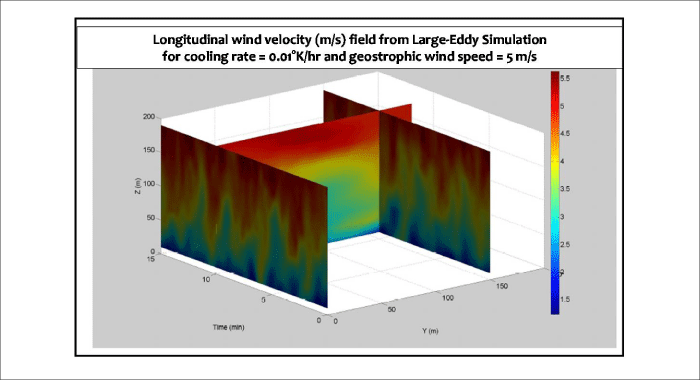
Publications:
C. Sim, S. Basu, and L. Manuel, "The Influence of Stable Boundary Layer Flows on Wind Turbine Fatigue Loads," Proceedings of the 47th AIAA Aerospace Sciences Meeting and Exhibit, Paper No. AIAA-2009-1405, Orlando, Florida, January 2009.
C. Sim, "Simulation and Analysis of Wind Turbine Loads for Neutrally Stable Inflow Turbulence," M.S. Thesis, Department of Civil, Architectural, and Environmental Engineering, The University of Texas at Austin, August 2009.
J. Park, "On Characteristics of Stable Boundary Layer Flow Fields and their Influence on Wind Turbine Loads," M.S. Thesis, Department of Civil, Architectural, and Environmental Engineering, The University of Texas at Austin, August 2011.
C. Sim, S. Basu, and L. Manuel, "On Space-Time Resolution of Inflow Representations for Wind Turbine Loads Analysis," Energies, Vol. 5, No. 7, pp. 2071-2092, 2012.
Sponsor: Texas Higher Education Coordinating Board (ARP) and Sandia National Laboratories
Description:
In the design of wind turbines today, inflow turbulence is only simulated for near-neutral atmospheric stability considerations. Especially at Great Plains sites, stable boundary layer flows can alter the mean longitudinal wind speed profile and also introduce speed shear and wind direction variation that can be very different from neutral flows. For today’s utility-scale wind turbines, stable boundary layer flows can even introduce low-level jets at heights comparable to that of larger rotor dimensions. It has been suggested that faults and fatigue damage have been disproportionately observed, for example, during nocturnal low-level jets that appear in stable atmospheric conditions. This study is seeking to develop procedures for simulating such stable flows, the turbine response to such flows, and resulting fatigue damage. These are being compared to similar computations for neutral flows. Ultimately, the objective of this research is to introduce into the design guidelines a procedure for simulation of inflow turbulence that accounts for atmospheric stability.
Images:

Publications:
C. Sim, S. Basu, and L. Manuel, "The Influence of Stable Boundary Layer Flows on Wind Turbine Fatigue Loads," Proceedings of the 47th AIAA Aerospace Sciences Meeting and Exhibit, Paper No. AIAA-2009-1405, Orlando, Florida, January 2009.
C. Sim, "Simulation and Analysis of Wind Turbine Loads for Neutrally Stable Inflow Turbulence," M.S. Thesis, Department of Civil, Architectural, and Environmental Engineering, The University of Texas at Austin, August 2009.
J. Park, "On Characteristics of Stable Boundary Layer Flow Fields and their Influence on Wind Turbine Loads," M.S. Thesis, Department of Civil, Architectural, and Environmental Engineering, The University of Texas at Austin, August 2011.
C. Sim, S. Basu, and L. Manuel, "On Space-Time Resolution of Inflow Representations for Wind Turbine Loads Analysis," Energies, Vol. 5, No. 7, pp. 2071-2092, 2012.



